HAVING SEX WITH ROBOTS INSIDE STORES THAT SELL THEM IS NOW ILLEGAL ACROSS ALL OF HARRIS COUNTY 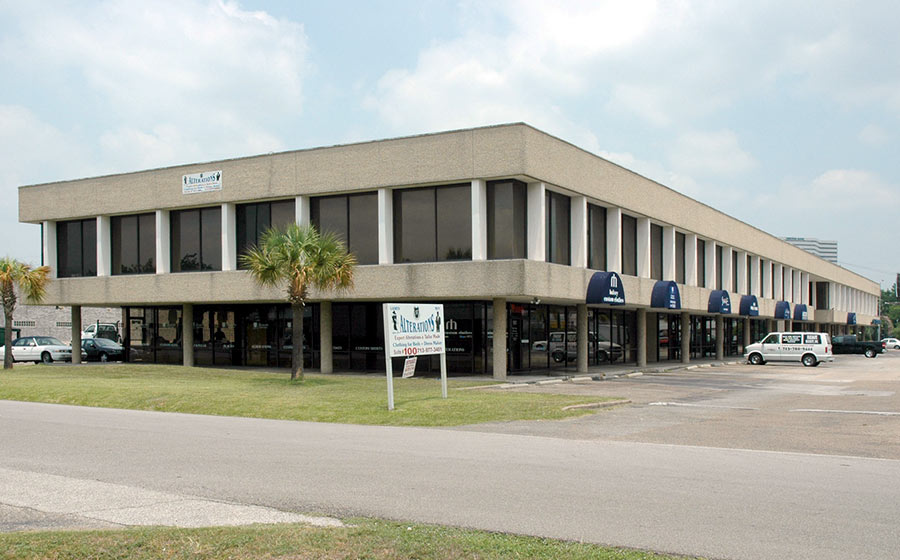 Piggybacking on Houston City Council’s own pioneering efforts to outlaw sex doll brothels within city limits, the county has now adopted similar legislation. On Tuesday, the Commissioners Court voted unanimously to “define sex dolls . . . as ‘anthropomorphic devices’ and prohibit companies from renting them out to customers,” reports the Chronicle’s Zach Despart. (Taking the dolls home remains legal.) The new rules take effect on January 1. [Houston Chronicle; previously on Swamplot] Photo of 5615 Richmond, formerly planned to house a sex doll brothel
Piggybacking on Houston City Council’s own pioneering efforts to outlaw sex doll brothels within city limits, the county has now adopted similar legislation. On Tuesday, the Commissioners Court voted unanimously to “define sex dolls . . . as ‘anthropomorphic devices’ and prohibit companies from renting them out to customers,” reports the Chronicle’s Zach Despart. (Taking the dolls home remains legal.) The new rules take effect on January 1. [Houston Chronicle; previously on Swamplot] Photo of 5615 Richmond, formerly planned to house a sex doll brothel
Tag: Development Regulations
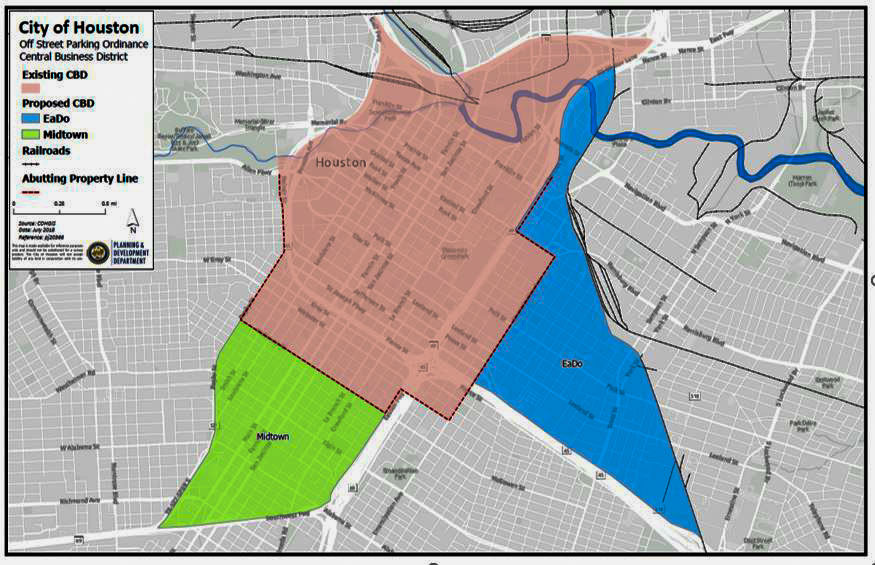
The city’s latest proposal to eliminate off-street parking requirements in Midtown and East Downtown got a vote of confidence from the management districts of both neighborhoods when staff members presented it to them last Monday. Shown above are the new areas (in blue and green) that’d supplement Downtown’s existing Central Business District (red) where developers are free to build without leaving room — like the rest of Houston must — for on-site parking spots. To the east, the designation extends out to the Union Pacific Railroad tracks and then down to I-45. And to the south, it follows the 527 spur, ending at 59. (If put in place, the whole contiguous zone would fall under a new term the city’s invented for it: Market Based Parking.)
There’s still a ways to go before the map becomes more than a pretty picture: A 30-day public comment period will culminate in a recap next month. Then city council gets its final say on things at a meeting proponents hope will take place before the end of the year.
WALK THIS WAY 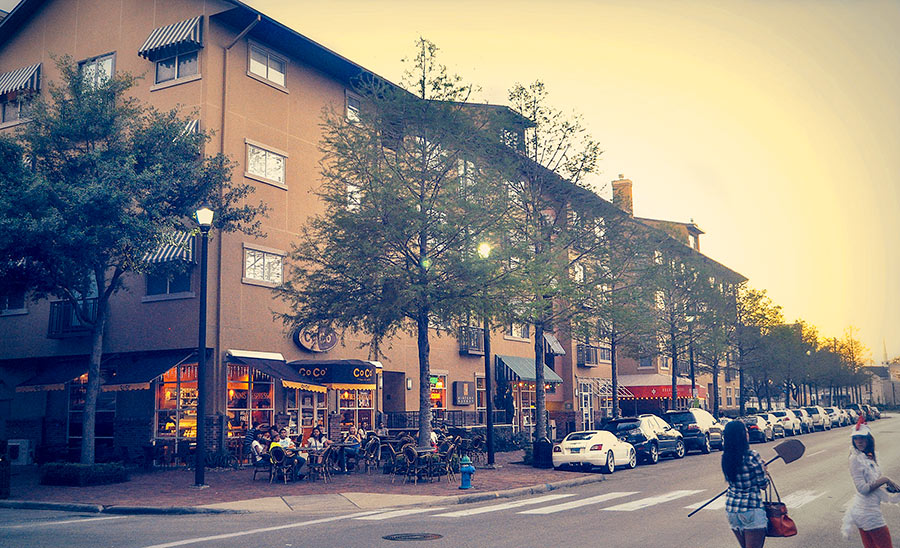 Only 17 percent of projects eligible for incentives included in the city’s 8-year-old Transit Corridor ordinance have taken advantage of them, reports Hilary Ybarra. So the next city initiative aimed at walkability will take a different approach: “The recently established Walkable Places Committee has been tasked with reevaluating the city code to dive deeper into the issue of walkability in Houston. The committee is currently focused on creating an application-based process to establish specific ‘walkable place’ areas,” she writes. “Under this new system, any neighborhood could voluntarily apply to become a ‘walkable place’ and in doing so establish their own set of self-defined unique rules for development to encourage walkability. These rules would include specific regulations covering the building setback, design of the pedestrian realm, landscaping, pedestrian friendly building design, and parking (a separate subcommittee has been formed exclusively to deal with parking).
But once adopted, unlike the Transit Corridor Ordinance, neighborhood- and site-specific building rules would be required, not optional, for all new development. Though still in the early planning stages — adoption of a new ordinance is targeted for 2019 — the proposal certainly faces challenges. How will a neighborhood come to consensus on new guidelines? What are the incentives to apply to become a ‘walkable place?’ What will trigger the application of the new guidelines to existing development? Are historic structures exempt? And perhaps most importantly, what about the spaces between and connecting to the specific neighborhoods?” [The Urban Edge] Photo of Gray St., Midtown:Â Mark Taylor Cunningham (license)
Only 17 percent of projects eligible for incentives included in the city’s 8-year-old Transit Corridor ordinance have taken advantage of them, reports Hilary Ybarra. So the next city initiative aimed at walkability will take a different approach: “The recently established Walkable Places Committee has been tasked with reevaluating the city code to dive deeper into the issue of walkability in Houston. The committee is currently focused on creating an application-based process to establish specific ‘walkable place’ areas,” she writes. “Under this new system, any neighborhood could voluntarily apply to become a ‘walkable place’ and in doing so establish their own set of self-defined unique rules for development to encourage walkability. These rules would include specific regulations covering the building setback, design of the pedestrian realm, landscaping, pedestrian friendly building design, and parking (a separate subcommittee has been formed exclusively to deal with parking).
But once adopted, unlike the Transit Corridor Ordinance, neighborhood- and site-specific building rules would be required, not optional, for all new development. Though still in the early planning stages — adoption of a new ordinance is targeted for 2019 — the proposal certainly faces challenges. How will a neighborhood come to consensus on new guidelines? What are the incentives to apply to become a ‘walkable place?’ What will trigger the application of the new guidelines to existing development? Are historic structures exempt? And perhaps most importantly, what about the spaces between and connecting to the specific neighborhoods?” [The Urban Edge] Photo of Gray St., Midtown:Â Mark Taylor Cunningham (license)
COMMENT OF THE DAY: HOUSTON IS USUALLY BETTER WHERE IT ISN’T PLANNED TO BE  “I’m going to go ahead and disagree on the value of planning. The best parts of the city (19th St, parts of Washington, parts of Midtown) were developed before the city passed Chapter 42, and would be illegal to replicate today.
What has planning gotten our fair city over the past half-century? Here’s a partial list:
1.) Density caps inside the loop (since repealed), driving multifamily development to areas farther away from downtown, increasing sprawl.
2.) 70+ ft. right-of-ways, which, along with our 25-ft setbacks, result in an absurd 120 feet between facades. Compare that to unplanned, human-scaled environments in pre-19th century cities and the result is 25% of land completely wasted, or given over to automobiles instead of people.
3.) Parking minimums, requiring up to 75% of land be given over to car storage.
4.) 25-ft. retail setbacks, which, combined with parking minimums, essentially mandate strip-mall development.
What Houston does well is where it doesn’t ‘plan.’ We don’t segregate residential, commercial and retail. We don’t limit residential density (much) (inside the loop), we don’t cap multi-family density (any more). All those great, walkable places we travel to on vacation have one thing in common: the almost complete lack of planning. And where they did do ‘planning’ it did more harm than good. The gothic quarter in Barcelona is way more charming than the Eixample, and don’t get me started on how Haussmann screwed up Paris.
Lump me in with the anti-planners on this one.” [Angostura, commenting on Comment of the Day: What Parking Requirements for Bars Really Encourage] Illustration: Lulu
“I’m going to go ahead and disagree on the value of planning. The best parts of the city (19th St, parts of Washington, parts of Midtown) were developed before the city passed Chapter 42, and would be illegal to replicate today.
What has planning gotten our fair city over the past half-century? Here’s a partial list:
1.) Density caps inside the loop (since repealed), driving multifamily development to areas farther away from downtown, increasing sprawl.
2.) 70+ ft. right-of-ways, which, along with our 25-ft setbacks, result in an absurd 120 feet between facades. Compare that to unplanned, human-scaled environments in pre-19th century cities and the result is 25% of land completely wasted, or given over to automobiles instead of people.
3.) Parking minimums, requiring up to 75% of land be given over to car storage.
4.) 25-ft. retail setbacks, which, combined with parking minimums, essentially mandate strip-mall development.
What Houston does well is where it doesn’t ‘plan.’ We don’t segregate residential, commercial and retail. We don’t limit residential density (much) (inside the loop), we don’t cap multi-family density (any more). All those great, walkable places we travel to on vacation have one thing in common: the almost complete lack of planning. And where they did do ‘planning’ it did more harm than good. The gothic quarter in Barcelona is way more charming than the Eixample, and don’t get me started on how Haussmann screwed up Paris.
Lump me in with the anti-planners on this one.” [Angostura, commenting on Comment of the Day: What Parking Requirements for Bars Really Encourage] Illustration: Lulu
COMMENT OF THE DAY: WE TRIED THAT NO PARKING REQUIREMENTS THING BEFORE, IN AVONDALE  “The urban fantasists who don’t believe in minimum parking should school themselves on the economic concept of the free rider and the common law concept of nuisance. They should also research a little of the history behind Houston minimum parking requirements. These regs did not emerge in a vacuum.
I lived in Avondale, in Montrose, during the nineties, when it was home to no less than nine bars, multiple restaurants, and other adult businesses, all without parking and no parking requirements. Houston minimum parking requirements arose because of what was going on in Avondale and a few other neighborhoods inside the Loop.
The patrons of these bars and restaurants did not and still do not live within Avondale. They all drove to Avondale because there was and is still no other way to get there. The bar owners did not provide parking, choosing instead to impose the costs of their patron parking on the city and the residents of Avondale (free rider). The patrons parked, imbibed, and then proceeded to be drunken asses all night disturbing the peace of the neighborhood (nuisance).
Forcing the business owner to bear the costs of patron parking shifts the costs back to the business which benefits from the patronage. It is a reasonable requirement. It also alleviates the nuisance issue by keeping the drunks off the property of other businesses and residences.” [Jardinero1, commenting on Comment of the Day: What Parking Requirements for Bars Really Encourage] Illustration: Lulu
“The urban fantasists who don’t believe in minimum parking should school themselves on the economic concept of the free rider and the common law concept of nuisance. They should also research a little of the history behind Houston minimum parking requirements. These regs did not emerge in a vacuum.
I lived in Avondale, in Montrose, during the nineties, when it was home to no less than nine bars, multiple restaurants, and other adult businesses, all without parking and no parking requirements. Houston minimum parking requirements arose because of what was going on in Avondale and a few other neighborhoods inside the Loop.
The patrons of these bars and restaurants did not and still do not live within Avondale. They all drove to Avondale because there was and is still no other way to get there. The bar owners did not provide parking, choosing instead to impose the costs of their patron parking on the city and the residents of Avondale (free rider). The patrons parked, imbibed, and then proceeded to be drunken asses all night disturbing the peace of the neighborhood (nuisance).
Forcing the business owner to bear the costs of patron parking shifts the costs back to the business which benefits from the patronage. It is a reasonable requirement. It also alleviates the nuisance issue by keeping the drunks off the property of other businesses and residences.” [Jardinero1, commenting on Comment of the Day: What Parking Requirements for Bars Really Encourage] Illustration: Lulu
COMMENT OF THE DAY: WHAT PARKING REQUIREMENTS FOR BARS REALLY ENCOURAGE  “Uggh . . . Every thread on here, or nextdoor, etc., about a new bar or restaurant attracts an inevitable ‘where will all these people park?‘ comment.
Why do people feel the need to drive to this bar, and the others in the vicinity? Because our obsession with parking requires every bar or restaurant to dedicate 3/4 of their land area to machinery storage, making everything so far apart you can’t walk anywhere.
Wouldn’t it make more sense to PROHIBIT bars from having parking lots, instead? Why does our city REQUIRE bar operators to subsidize one of the most dangerous and reckless activities people regularly engage in — drinking and driving — by forcing bars to provide parking for their patrons? Wouldn’t you rather the bars in your neighborhood made it as difficult as possible for people to drive there, and take an Uber instead?
Let’s keep the drunks off our streets: Zero out the parking minimum on any establishment with an on-premise liquor license.” [Angostura, commenting on The Up-Scaled Bungalow Bar Now Puffing Up in Shady Acres Across from Cedar Creek] Illustration: Lulu
“Uggh . . . Every thread on here, or nextdoor, etc., about a new bar or restaurant attracts an inevitable ‘where will all these people park?‘ comment.
Why do people feel the need to drive to this bar, and the others in the vicinity? Because our obsession with parking requires every bar or restaurant to dedicate 3/4 of their land area to machinery storage, making everything so far apart you can’t walk anywhere.
Wouldn’t it make more sense to PROHIBIT bars from having parking lots, instead? Why does our city REQUIRE bar operators to subsidize one of the most dangerous and reckless activities people regularly engage in — drinking and driving — by forcing bars to provide parking for their patrons? Wouldn’t you rather the bars in your neighborhood made it as difficult as possible for people to drive there, and take an Uber instead?
Let’s keep the drunks off our streets: Zero out the parking minimum on any establishment with an on-premise liquor license.” [Angostura, commenting on The Up-Scaled Bungalow Bar Now Puffing Up in Shady Acres Across from Cedar Creek] Illustration: Lulu
THE HEIGHTS HISTORIC DISTRICTS’ NEW HEIGHTS 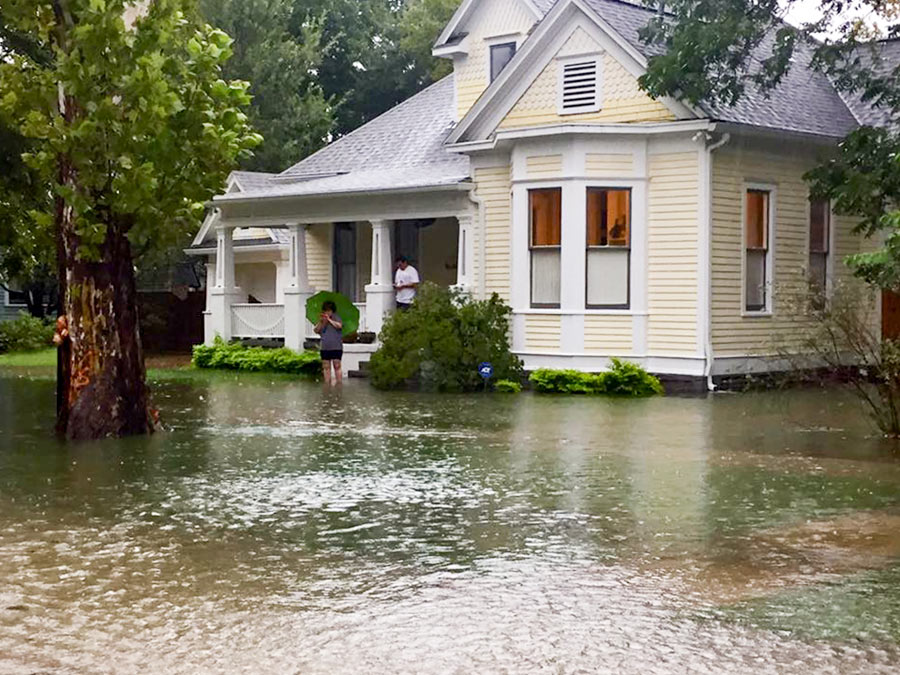 The public comment period for the latest (and presumably final) draft of the design guidelines for the Houston Heights’s 3 historic districts ends today. The latest version of the 223-page document dates from August and covers a range of issues important to the historic districts, including proposed standards for construction and renovation — from roof pitches and “character defining elements” to maximum allowable foundation height (30 inches from natural elevation for new construction and additions) — but does not appear to include any mention of flooding. The guidelines, once adopted, would be used by the Houston Archeological and Historical Commission in its determinations of what proposed building projects would be allowed. [Planning & Development Dept.; previously on Swamplot] Photo of home at 8th St. and Arlington St., in Houston Heights Historic District South, during Harvey: Swamplot inbox
The public comment period for the latest (and presumably final) draft of the design guidelines for the Houston Heights’s 3 historic districts ends today. The latest version of the 223-page document dates from August and covers a range of issues important to the historic districts, including proposed standards for construction and renovation — from roof pitches and “character defining elements” to maximum allowable foundation height (30 inches from natural elevation for new construction and additions) — but does not appear to include any mention of flooding. The guidelines, once adopted, would be used by the Houston Archeological and Historical Commission in its determinations of what proposed building projects would be allowed. [Planning & Development Dept.; previously on Swamplot] Photo of home at 8th St. and Arlington St., in Houston Heights Historic District South, during Harvey: Swamplot inbox
THAT THING ABOUT THE CITY OF HOUSTON AND DIGITAL BILLBOARDS  A reader with “nothing better to do today” writes in with a question for Swamplot readers: “I do not see any digital billboards in Houston city limits. I see them popping up in Baytown and I’m sure elsewhere, but why not H-Town? One would think that this would be a win-win for the owners of the billboards and the businesses wanting to advertise their product. I see them all over Dallas — Houston, not so much.” Photo: Houston Public Media
A reader with “nothing better to do today” writes in with a question for Swamplot readers: “I do not see any digital billboards in Houston city limits. I see them popping up in Baytown and I’m sure elsewhere, but why not H-Town? One would think that this would be a win-win for the owners of the billboards and the businesses wanting to advertise their product. I see them all over Dallas — Houston, not so much.” Photo: Houston Public Media
COMMENT OF THE DAY: THE RISKY GAME HOUSTON’S BEEN PLAYING ALL THESE YEARS  “It is really amazing to look at the total disaster that Harvey caused (And Ike. And Allison. And the Tax Day flood. And the Memorial Day flood.) and say to developers and regulators in the Houston area, “Doing a heck of a job, Brownie.†Developers and regulators built thousands of homes and strip malls all across Houston during the boom cycles of the ’60s, ’70s, and early ’90s that had completely insufficient stormwater drainage infrastructure. Regulators allowed people to build too close to flood zones and builders did not think twice about building right up to bayous and rivers. The response from regulators was to require better development practices moving forward in some areas and apply a few band aids in other areas. This lax development attitude worked for a long time because it helped keep housing relatively affordable compared to other large metro areas. But after Harvey, people looking to come to Houston will have to consider whether the affordable housing and economic opportunities are worth the risk of losing everything in another big flooding event. The reassurance that developers are doing a better job with new projects does nothing to allay fears that existing housing is prone to devastating flooding. Houston’s failed development practices are now an albatross around the City’s neck.” [Old School, commenting on Comment of the Day: What Out-of-Town Reporters Don’t Understand About Houston-Area Development Regulations] Illustration: Lulu
“It is really amazing to look at the total disaster that Harvey caused (And Ike. And Allison. And the Tax Day flood. And the Memorial Day flood.) and say to developers and regulators in the Houston area, “Doing a heck of a job, Brownie.†Developers and regulators built thousands of homes and strip malls all across Houston during the boom cycles of the ’60s, ’70s, and early ’90s that had completely insufficient stormwater drainage infrastructure. Regulators allowed people to build too close to flood zones and builders did not think twice about building right up to bayous and rivers. The response from regulators was to require better development practices moving forward in some areas and apply a few band aids in other areas. This lax development attitude worked for a long time because it helped keep housing relatively affordable compared to other large metro areas. But after Harvey, people looking to come to Houston will have to consider whether the affordable housing and economic opportunities are worth the risk of losing everything in another big flooding event. The reassurance that developers are doing a better job with new projects does nothing to allay fears that existing housing is prone to devastating flooding. Houston’s failed development practices are now an albatross around the City’s neck.” [Old School, commenting on Comment of the Day: What Out-of-Town Reporters Don’t Understand About Houston-Area Development Regulations] Illustration: Lulu
COMMENT OF THE DAY: WHAT OUT-OF-TOWN REPORTERS DON’T UNDERSTAND ABOUT HOUSTON-AREA DEVELOPMENT REGULATIONS  “. . . I must LOL whenever I see one of these articles blaming our flooding on our lack of zoning, and as an example of our lack of zoning, the article will show some subdivision in Sugar Land or Katy. Last time I checked, neither of those places are inside the city limits of Houston. Also, don’t those subdivisions have zoning up the ying yang? . . .” [XCellKen, commenting on Harvey’s Record Rainfall; Crosby Plant Explosion Risk; A Ponderosa Forest Boat Ride] Illustration: Lulu
“. . . I must LOL whenever I see one of these articles blaming our flooding on our lack of zoning, and as an example of our lack of zoning, the article will show some subdivision in Sugar Land or Katy. Last time I checked, neither of those places are inside the city limits of Houston. Also, don’t those subdivisions have zoning up the ying yang? . . .” [XCellKen, commenting on Harvey’s Record Rainfall; Crosby Plant Explosion Risk; A Ponderosa Forest Boat Ride] Illustration: Lulu
RESTRICTIONS ON MUNICIPAL TREE ORDINANCES CUT DOWN, SIGNED BY GOVERNOR 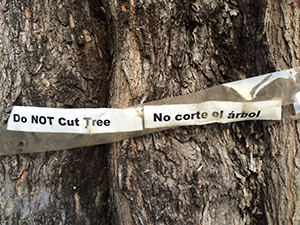 The special session of the Texas Legislature ended without passing a law — which Governor Abbott had wanted — banning cities from regulating owners’ rights to cut down trees on their property. But the Lege didn’t exactly leave the issue alone, either: HB7, signed into law earlier this week by Governor Abbott and scheduled to go into effect on December 1, prevents municipalities (that haven’t already done so) from charging homeowners a fee for trees cut down on their property that are smaller than 10 in. — and requires cities that levy any mitigation fee for cutting down larger trees to also allow a credit for planting 2-in.-diameter replacements. The credits would be required to range from 40 percent to 100 percent of the fee itself; if the property is an owner-occupied residence, the credit would have to equal the mitigation fee. [Houston Chronicle ($); bill text; previously on Swamplot] Photo: Swamplot inbox
The special session of the Texas Legislature ended without passing a law — which Governor Abbott had wanted — banning cities from regulating owners’ rights to cut down trees on their property. But the Lege didn’t exactly leave the issue alone, either: HB7, signed into law earlier this week by Governor Abbott and scheduled to go into effect on December 1, prevents municipalities (that haven’t already done so) from charging homeowners a fee for trees cut down on their property that are smaller than 10 in. — and requires cities that levy any mitigation fee for cutting down larger trees to also allow a credit for planting 2-in.-diameter replacements. The credits would be required to range from 40 percent to 100 percent of the fee itself; if the property is an owner-occupied residence, the credit would have to equal the mitigation fee. [Houston Chronicle ($); bill text; previously on Swamplot] Photo: Swamplot inbox
COMMENT OF THE DAY: AN IMPORTANT RULE ABOUT LOCAL RULE  “What seems weird to me is the idea that one government body is passing a law that says that other government bodies are not allowed to pass laws that do certain specific things. Maybe this is common and I’ve just never noticed it before, but it seems like a brazen attempt by one ideological group to attempt to use their success getting elected into a majority in one jurisdiction to legislate (or block legislation) in another jurisdiction where they were not able to get elected into a majority.” [wcthoms, commenting on The State of Texas and the Right To Cut Down Trees Without Notice] Illustration: Lulu
“What seems weird to me is the idea that one government body is passing a law that says that other government bodies are not allowed to pass laws that do certain specific things. Maybe this is common and I’ve just never noticed it before, but it seems like a brazen attempt by one ideological group to attempt to use their success getting elected into a majority in one jurisdiction to legislate (or block legislation) in another jurisdiction where they were not able to get elected into a majority.” [wcthoms, commenting on The State of Texas and the Right To Cut Down Trees Without Notice] Illustration: Lulu
THE STATE OF TEXAS AND THE RIGHT TO CUT DOWN TREES WITHOUT NOTICE  “. . . a municipality, county, or other political subdivision may not enact or enforce any ordinance, rule, or other regulation that restricts the ability of a property owner to remove a tree or vegetation on the owner’s property, including a regulation that requires the owner to file an affidavit or notice before removing the tree or vegetation.” That wording — minus only a few dozen lines of accompanying legalese — forms the core of the new HB 70, a state bill introduced this month to enact the ban on local tree regulations Governor Abbott announced he wanted passed during the Texas legislature’s special session. Among the 50 or so Texas cities that would see their restrictions on the removal of trees from private property removed should the bill become law: West University Place. [Legiscan; Texas Tribune; previously on Swamplot] Photo: Swamplot inbox
“. . . a municipality, county, or other political subdivision may not enact or enforce any ordinance, rule, or other regulation that restricts the ability of a property owner to remove a tree or vegetation on the owner’s property, including a regulation that requires the owner to file an affidavit or notice before removing the tree or vegetation.” That wording — minus only a few dozen lines of accompanying legalese — forms the core of the new HB 70, a state bill introduced this month to enact the ban on local tree regulations Governor Abbott announced he wanted passed during the Texas legislature’s special session. Among the 50 or so Texas cities that would see their restrictions on the removal of trees from private property removed should the bill become law: West University Place. [Legiscan; Texas Tribune; previously on Swamplot] Photo: Swamplot inbox
COMMENT OF THE DAY: THE BIG THINGS YOU GET WHEN YOU LEAVE JUST A TINY SPACE BETWEEN HOUSES 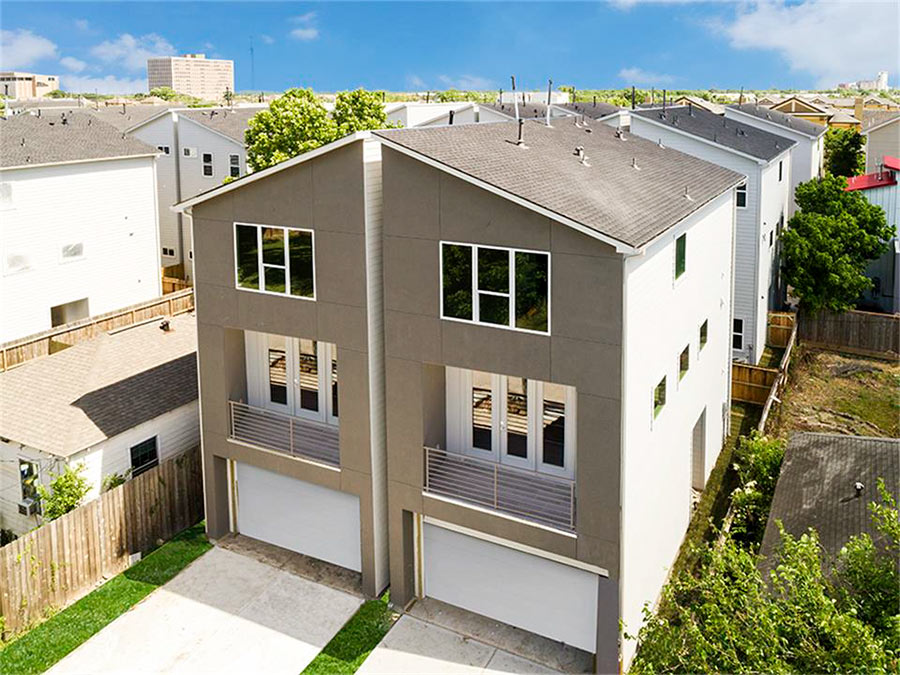 “The City of Houston’s codes are different for a ‘free-standing’ or ‘detached’ ‘single-family’ home, as opposed to a two- or multi-family property of some sort. Detention, lot coverage, building code, legal description, all different. So maintaining even the tiniest gap means you have a fee-simple, stand-alone property.” [dave102, commenting on Can You Beat This Townhome Gap?] Photo of 3108 Baer St., Fifth Ward: HAR
“The City of Houston’s codes are different for a ‘free-standing’ or ‘detached’ ‘single-family’ home, as opposed to a two- or multi-family property of some sort. Detention, lot coverage, building code, legal description, all different. So maintaining even the tiniest gap means you have a fee-simple, stand-alone property.” [dave102, commenting on Can You Beat This Townhome Gap?] Photo of 3108 Baer St., Fifth Ward: HAR
COMMENT OF THE DAY: WHY THINGS LITERALLY LOOK BRIGHTER ON HOUSTON’S HORIZONS  “Actually, Houston has substantially improved both air and water quality in the past few decades. I remember the haze days back in the early 90’s when you could not see more than a few miles through the smog when driving down the Katy Freeway, nor could you see the tops of the taller buildings. Also, nearly all of the illegal water pollution sources have been permitted and/or rerouted into treatment systems. The ones that haven’t are eventually caught and have to pay hefty fines, or the responsible people go to jail. It is true that much of the improvement was driven by federal and state regulation that trickled down to Houston, but that is true for most major cities.” [Superdave, commenting on Comment of the Day: Making Sure the House Wins Houston’s Toxicity Gamble] Illustration: Lulu
“Actually, Houston has substantially improved both air and water quality in the past few decades. I remember the haze days back in the early 90’s when you could not see more than a few miles through the smog when driving down the Katy Freeway, nor could you see the tops of the taller buildings. Also, nearly all of the illegal water pollution sources have been permitted and/or rerouted into treatment systems. The ones that haven’t are eventually caught and have to pay hefty fines, or the responsible people go to jail. It is true that much of the improvement was driven by federal and state regulation that trickled down to Houston, but that is true for most major cities.” [Superdave, commenting on Comment of the Day: Making Sure the House Wins Houston’s Toxicity Gamble] Illustration: Lulu

